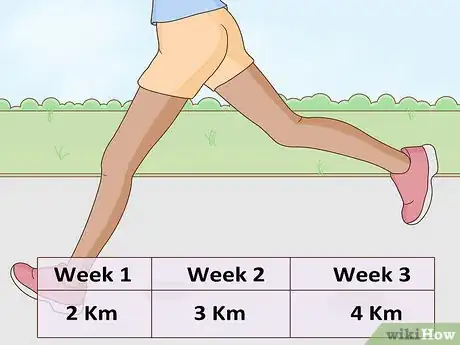This article was co-authored by Tyler Courville. Tyler Courville is a brand ambassador for Salomon Running. He has run in 10 ultra and mountain races across the United States and Nepal, and won the 2018 Crystal Mountain Marathon.
There are 13 references cited in this article, which can be found at the bottom of the page.
This article has been viewed 77,739 times.
When you're getting ready for a cross country race, you might feel overwhelmed. However, it is important to train a little every day rather than all at once. By running and cross-training (with a weekly rest day), you can prepare to do the best at your competition. All that work will pay off when the race is over and you can rest knowing that you did your best.
Steps
Improving Running Endurance
-
1Try interval training. Interval training involves alternating between periods (known as intervals) of high-intensity exercise with low-intensity exercise. Switch between sprinting and walking in 2 to 3 minute intervals. This is very good for stamina.Your run can last anywhere from thirty minutes to an hour, depending on the distance you choose. During the high-intensity interval, give the workout as much energy as you can to increase your strength.[1]
- Plan an interval run at least once per week.
EXPERT TIPTyler Courville is a brand ambassador for Salomon Running. He has run in 10 ultra and mountain races across the United States and Nepal, and won the 2018 Crystal Mountain Marathon.Professional Runner
 Tyler Courville
Tyler Courville
Professional RunnerTyler Courville, ultra and mountain runner, advises: “I think for most people when you’re beginning it’s helpful to do a weekly rotation, which consists of one long run a week, one kind of interval, and maybe one up-tempo run. Then, the rest of the days, I let my body guide what I'm doing. My mentality is that if your run doesn’t have a name (if it’s not long run or hill sprints, for example) then it’s recovery.”
-
2Do twenty-minute tempo runs. Run at a speed 15 to 30 seconds slower than your race pace to practice controlling your speed. On a scale from one to ten, tempo runs should put your exertion level at around an eight. Because tempo runs increase metabolic fitness, this exercise can prevent fatigue on your race day.[2]Advertisement
-
3Run a fartlek workout. Fartlek is Swedish for "speed play," and this workout is a variation of interval training meant to prepare you for the varied pacing of cross country runs. Instead of alternating between an intense and easy workout, your pace will vary between intense and moderate. A good fartlek workout can last anywhere from thirty minutes to an hour.[3]
- For example, you might sprint for three minutes, jog for three minutes, and then repeat this process five times.
- Practice fartlek runs on uneven courses with plenty of uphill and downhill to simulate racing conditions.
-
4Work in a 10% longer run every week. It is important to build up your running distance gradually. To do this, plan a 10% longer run every week to work up to the race's distance. For example, if you're running a 5K (3.1 mi), you could run 2 kilometers (1.2 mi) one week, 2.2 kilometers (1.4 mi) the next, and 2.4 kilometers (1.5 mi) the next week. Keep increasing your distance by 10% until you reach your goal of 5k (3.1) miles.
- Don't start out at your fastest pace during longer runs. Start slow and gradually build your speed.
- Do not plan your long run on the day before your competition to avoid burnout.
-
5Plan one recovery run a week. On the day after your longer run, do a recovery run to decrease lactic acid buildup in your muscles (which can cause stiffness). Maintain a steady, slow pace for around 20 to 30 minutes. You should be able to breathe and talk with ease while you run.
- Recovery runs also reduce the effect of delayed onset muscle soreness (DOMS) after heavy workouts.
Cross-Training
-
1Work in two or three cross-training days per week. While training for a cross country competition, three or four days should consist of running. For the remaining days, try other exercises to strengthen your full body and give your running muscles a break.
- Choose cross-training workouts you enjoy. You might, for example, swim, bike, ski, weight lift, or hike.
-
2Have one rest day per week as part of your cross-training schedule. Rest days allow your muscles to recover and avoid driving your body to exhaustion. Without a rest day, athletes are much more likely to sustain injuries. Plan a day to recharge, perform a light activity, and prepare for your workout tomorrow.[4]
- Examples of rest day activities include: stretching, walking, visiting a hot tub or sauna, hiking on an even trail, or doing yoga.
-
3Go cycling to increase your running speed. Pedaling on a bike can help you even out the cadence of your running, or how many steps you take per minute. Begin your cycling workout on a low tension setting to ease into the workout. Gradually increase the tension as you cycle to simulate going up hills.
- Work in 60-90 second intervals of high-tension cycling followed by low-tension recovery periods to interval train on the bike.
- If desired, you can go biking outdoors as an alternative. Look for a road or a trail with equal amounts of uphill and downhill.
-
4Try weight training once a week for endurance. Because endurance is key in cross country runs, schedule a strength training session weekly. Alternate between focusing on your arms, legs, and core during different weightlifting sessions. Start with lights weights and move onto heavier ones as you gain muscle.[5]
-
5Go swimming for an upper-body workout. Running mainly focuses on lower-body training, so swimming can keep your body balanced as you train. Lap swimming in a pool (as opposed to open water swimming) is ideal for cross-training, especially if you are new to swimming.
- Swimming workouts can last anywhere from thirty minutes to an hour, depending on how many laps you want to complete.
Maintaining a Healthy Lifestyle
-
1Get at least eight hours of sleep every night. Keeping healthy sleep habits will help you give your all during each workout or race. Most teenagers and adults need between 8-9 hours of sleep per week.[6]
- If you are a younger athlete (in middle or high school), try to get between eight and ten hours of sleep.
-
2Eat plenty of protein and carbohydrates. Carbohydrates provide the body with energy and stamina during hard workouts. Protein stabilizes blood sugar and helps you stay full. Aim for a serving of each in every meal to give your body balanced nutrition.[7]
- Runners should aim to get sixty to sixty-five percent of their calories from carbohydrates. Pasta, bread, cereal, dairy, sports drinks, and fruits are all great sources of carbs.[8]
- Healthy food with a high protein content include: eggs, nuts, beans, tofu, and white meat.
-
3Avoid foods with a high fat content. Some fat is important, but a runner's diet should be relatively low in fat. It should make up around twenty percent of your caloric intake and primarily come from monounsaturated fats (like avocados, olive oil, and nuts) instead of saturated fats (like whole milk, red meat, and butter).
-
4Stay hydrated. Drinking enough water can increase a runner's speed and stamina. How much water you should drink during a workout depends on the intensity and the environment you're exercising in. Keep an accessible supply of water or a sports drink with you while you exercise, and drink when you feel thirsty or notice signs of dehydration.
-
5Stretch after running. It is important to stretch your muscles after you complete a run. Stretching will help to alleviate cramps and release tension in your muscles. Stretch your legs, especially your calves, to help prevent cramping.
Doing Your Best at Competitions
-
1Inspect the race trail several days before you run. Ask your coach for a map of the course or, if running independently, check the race website for a map. Study the course either in-person or via the map, and make note of challenging areas (like long, steep hills). Make a racing plan as you survey the area so you can decide on a strategy.
- Suppose you notice three big hills near the end of your race. You could plan to run at a slower pace before you reach these hills to conserve energy.
-
2Eat high-carbohydrate foods four hours before your race. Four hours gives your body enough time to digest the food and turn it into energy. At least eighty percent of your pre-race meal should be carbohydrates. Avoid food with high fat, fiber, or protein content.[11]
- Drink something with a high carbohydrate content, like chocolate milk or a sports drink.
- Bread, oatmeal, or pasta all make ideal meals before a race.
-
3Practice visualization before the race begins. Imagining yourself doing your best and reaching your goals can actually help you achieve them. One or two hours beforehand, picture yourself running the race and doing well. When it's time to race, you'll feel more confident and prepared to compete.[12]
- Include vivid details, like the weather or the runners around you, to make the visualization seem real.
- Picture positive as well as negative moments. When setbacks occur during the race, you'll face them with less anxiety.
-
4Run at an even pace. Fully exerting yourself at the beginning of a cross country race will swiftly sap your stamina. If your sprinting pace is eight miles per hour, go for five or six miles per hour at first. Increase your speed as you near the end of the race.
-
5Make the most of your strengths. Run fastest in the areas you feel most confident in. If you love running downhill, speed your way down. Or, if you prefer uphill running, conserve your energy on the even or downhill areas so you can climb the hills with confidence.
Expert Q&A
-
QuestionHow far do you run in cross country?
 Michele DolanMichele Dolan is a BCRPA certified Personal Trainer in British Columbia. She has been a personal trainer and fitness instructor since 2002.
Michele DolanMichele Dolan is a BCRPA certified Personal Trainer in British Columbia. She has been a personal trainer and fitness instructor since 2002.
Certified Fitness Trainer Cross country runs are between 3 and 5 km (3 miles) depending on your age and gender. Men's runs tend to be longer (5 km), and girls' and women's runs are more often 3-4 km.
Cross country runs are between 3 and 5 km (3 miles) depending on your age and gender. Men's runs tend to be longer (5 km), and girls' and women's runs are more often 3-4 km. -
QuestionHow does a long distance runner train?
 Michele DolanMichele Dolan is a BCRPA certified Personal Trainer in British Columbia. She has been a personal trainer and fitness instructor since 2002.
Michele DolanMichele Dolan is a BCRPA certified Personal Trainer in British Columbia. She has been a personal trainer and fitness instructor since 2002.
Certified Fitness Trainer A long distance runner needs to pick up the pace for cross country, so practice sprints and fartleks, as well as agility drills like the ladder. Cross country running requires the runners to pick up their feet more.
A long distance runner needs to pick up the pace for cross country, so practice sprints and fartleks, as well as agility drills like the ladder. Cross country running requires the runners to pick up their feet more. -
QuestionHow do you score in cross country?
 Michele DolanMichele Dolan is a BCRPA certified Personal Trainer in British Columbia. She has been a personal trainer and fitness instructor since 2002.
Michele DolanMichele Dolan is a BCRPA certified Personal Trainer in British Columbia. She has been a personal trainer and fitness instructor since 2002.
Certified Fitness Trainer Cross country races are scored by the time it takes you to run the course. You run against competitors of your own age and gender.
Cross country races are scored by the time it takes you to run the course. You run against competitors of your own age and gender.
Warnings
- Avoid caffeine on workout or competition days. Caffeine highs (and lows) can adversely change your running habits.⧼thumbs_response⧽
- Wear reflective clothing while running at night to make yourself more visible to cars. Never assume that a car sees you and always run facing traffic.⧼thumbs_response⧽
- Never run alone before the sun rises or after the sun sets. If you have to run alone, then bring your dog with you (if you have one).[13]⧼thumbs_response⧽
References
- ↑ http://www.halhigdon.com/training/51325/Cross-Country-Summer-Training
- ↑ http://www.stack.com/a/cross-country-workouts
- ↑ https://www.runnersworld.co.uk/health/qa-how-do-i-do-fartlek
- ↑ https://www.wellbridge.com/fit-like-that/give-it-a-rest-its-ok-to-skip-your-workout
- ↑ https://www.active.com/cycling/articles/the-best-cross-training-for-runners
- ↑ https://sleepfoundation.org/how-sleep-works/how-much-sleep-do-we-really-need/page/0/2
- ↑ http://www.coolrunning.com/engine/2/2_1/162.shtml
- ↑ https://www.nytimes.com/guides/well/healthy-eating-for-runners
- ↑ http://www.mayoclinic.org/healthy-lifestyle/nutrition-and-healthy-eating/in-depth/water/art-20044256
About This Article
When you’re training for cross country running, it’s important to train a little every day to gradually build up your strength and stamina. Plan 30 minutes to 1 hour of interval training once a week, like by alternating between 2 to 3 minutes of running and walking. You should also increase the length of your practice runs by 10 percent each week to build up to the race distance. For example, if you start running 2 kilometers in training, move up to 2.2 kilometers the following week. The day after your long run, do a slower recovery run for about 20 minutes, which prevents lactic acid from building up in your muscles. Try to work in 2 to 3 days of cross training per week, such as biking or swimming, to strengthen all of your muscles. Remember to build in 1 rest day into your training program per week so your body gets time to rest, which will reduce your risk of injury. For tips from our Running co-author on how to eat healthily while training, keep reading!












































































